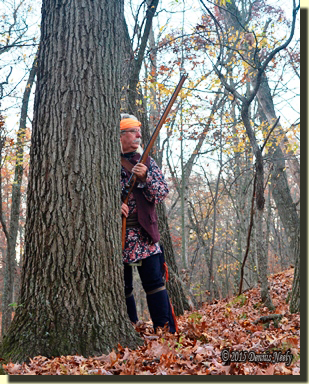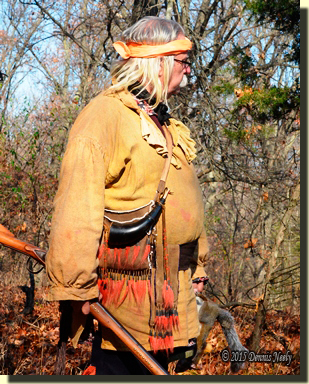Inquisitive fingers felt splintered openings. Msko-waagosh shook his head in amazement, the sulfurous stench of spent black powder still in his nostrils. Lead shot holes, shoulder-high on the returned white captive, peppered the barkless trunk of a dead red oak, but offered no answers to the woodland mystery.
On that late October evening, in the Year of our Lord, 1796, Msko-waagosh clenched his right fist, directing it back and forth, then up and down on the trunk. There were no missing holes, no voids in the perfect pattern left by the death bees. Overcome with disbelief, he moved his humble representation of the fox squirrel’s head and chest about again, seeking a location where the shot struck the vanished bushy-tail.
Msko-waagosh, called the “Red Fox” in the English tongue, examined the trunk for blood or short, auburn strands of hair. Crouching to one knee, he inspected the brittle, curled oak leaves at the tree’s base and behind. Again he shook his head as he fingered leaves. He scrambled to his feet, circled the tree, searching above and below the death bees final resting place, but to no avail.

In disgust, he grabbed up the Northwest gun and marched back to the stout red cedar tree, counting the paces, glancing back at the dead oak twice. He sat cross-legged on his trade blanket, rolled and bound with a leather portage collar. His mind recalled the fox squirrel’s leap from the shag-bark hickory’s jagged branch to the broken limb of the oak, the slow, unconcerned bounds to the limb’s juncture with the trunk and the casual dart to the far side of the hulk.
With its tail flicking and twitching, the squirrel circled the oak as it descended, once, twice, and then the long pause on the backside. Minutes it was. “You prayed for a clean kill or a clean miss,” he whispered to no one but himself.
The minute after the prayer afforded the time for the man mentored in the ways of the forest by his adoptive Ojibwe family to ease the smoothbore up, set the cock and rest his left elbow on his left, wool-clad knee, raised up by then. The Northwest gun’s turtle sight waited, steady, patient.
That fox squirrel rounded the grayed oak trunk close to the ground, head down and out, looking about, scanning the fresh-fallen leaves. The turtle held firm on the black eye, the one on the right, the animal’s left. The sharp English flint crashed. The squirrel’s tail flicked. Yellow sparks flew. The squirrel’s body turned upward. Black powder flashed. “Kla-whoosh-BOOM!”
Flames belched from the muzzle. White smoke roiled and billowed forth. The trade gun’s thunder echoed up and down the great swamp. The squirrel did not drop, did not thump in the leaves, did not thrash about as Msko-waagosh expected. And then in his mind, he recalled the flick of the tail, passing to the back of the tree, above where he aimed. “Oh,” he said with disgusted relief.
As he leaned back against the cedar tree, Msko-waagosh noticed the firelock’s cock was down, the pan coated with dry, black fouling. He looked about, concerned for his safety when he realized he had not reloaded. When the fox squirrel did not thump in the leaves, he ran straight to the oak. This was not his practice, which again caused a shaking of his head. He stood, pulled the hickory plug from his horn and began the loading process…
“What’s in Your Pouch?”
Msko-waagosh’s shot pouch holds just the basics for loading and servicing the Northwest trade gun: two spare flints, two or three priming wires, one or two gun worms, a wrought nail to tighten the cock’s jaw screw, a turkey wing bone and either a pouch of shot or seven lead balls. It also contains a buckskin wallet with hunting licenses and a brass powder measure, modern necessities dictated by law or safety concerns. Oh, and a pair of mismatched cuff buttons, which he never uses, fitting his linen outer shirt.
Mi-ki-naak’s pouch is a tad smaller in size. He keeps a wrought turn screw for the fusil’s cock-jaw screw, and he’s started carrying French amber flints instead of black, English flints.
The hired trading post hunter’s buckskin bag is the largest. It often includes a palm-sized Psalms and New Testament in a leather envelope, a burning glass in a cowhide case made by Darrel Lang (Leather from the Past), and sometimes the post hunter’s fire-starting kit in a thin leather sack. Lead balls or shot are kept in cowhide bags, Christmas gifts from Darrel. As one might expect, the license wallet moves from pouch to pouch, depending on which alter ego takes to the woods.

Either at the outdoor shows, or on hunting excursions, someone asks, “What’s in your pouch?” (One of these days I’m going to pull out a credit card, just to gauge the reaction.) In the wonderful world of living history, that question is ever prevalent.
At times, the inquisitor’s attitude switches from curiosity to the adversarial air of the “period-correct police.” A few items into the show and tell session, the question, “Do you have documentation for that,” raises its ugly head, save those instances when a viewer is genuinely interested in the historical background.
Many years ago, in part through the influence of Mark Baker’s writings, I evaluated each item based on documented primary sources consistent with the hired hunter’s persona. I followed that practice when Msko-waagosh and Mi-ki-naak came on the scene. Some necessities had no basis in 18th-century writings, some were carried, but kept on pack animals or left at a station camp, and some appeared over and over in the midst of the chase.
One of the goals of living history, and also traditional black powder hunting, is to discover what an individual had available and chose to use, then learn how those items fit into their backcountry lifestyle. John Tanner, Jonathan Alder, James Smith, Meshach Browning and the other hunter heroes I depend on, mention items in passing. Often times, the writings of two or more seasoned woodsmen are needed to complete a picture of common accoutrements.
In the end, the wilderness classroom provides the laboratory setting to test out these artifacts under first-hand, trial-and-error circumstances. Thus, through decades of field study, only a handful of “necessities” prove necessary.
I would be remiss if I did not mention that wilderness calamities happened, which turned a trade gun into nothing more than an expensive club. What has always intrigued me is the hearty hunter continues on, intending to repair the malady either at camp or at a local trading post—and they survived under that premise. Without a doubt, some did not make it, and thus they did not pen any memoirs.
Over the years, I have been taken to task with conversations that centered on “what you’re not carrying that you should,” followed by a listing of “must have accoutrements.”
Well, this week I ran across a blog post from several years ago. The link was sent to me in an email. The lecture began with, “A woodsman must be careful to distinguish between what you like to have along and what you need. You must balance minimum accoutrement weight against maximum survival efficiency.”
I don’t have a problem with those statements. I interpret the documentation with respect to my character, his chosen time period, his geographical location and his social standing, backed by practical, in-the-field experience. I am not criticizing what someone else interprets as correct for his or her persona. I offer this only as a point of comparison or contrast from a living historian’s perspective who is also a traditional black powder hunter.
The leather belt bag contains an oval brass box with fishing kit, an octagon brass box with tinder, flint and steel, and an “optional” brass compass.
The knapsack is of the “new improved” variety with a rolled wool blanket containing “spare clothes” and fixed with buckle straps. A drawstring bag contains the medical kit: rolled gauze, rolled bandage, 18th-century scissors, forceps and clamp, a modern hemostat and three antique bottles of medicines. A deerskin pouch holds a mainspring vice, spare lock screws, spare mainspring, frizzen spring and sear spring, worn frizzen and a wad cutting punch. A small brass kettle and tin cup is pictured, along with a linen sewing kit or “housewife.” Loose items include soap, a comb, whetstone, metal file, wooden spoon, a pair of moccasins and an awl.
A linen market wallet is shown, but the contents are not, other than noting sufficient food is carried “for a long stay.” An oil cloth is tucked between the bedroll and knapsack.
The leather shot pouch holds a ball bag, a shot bag, a drawstring bag with cleaning supplies, two flints, spare flint leather, turn screw, ball puller and a tin of grease, half a lead bar, brass mold and a lead ladle. Patched balls in a loading block, tin measure, pan brush and vent pick are attached to the woven strap.
A powder horn, tomahawk, long knife with sheath, patch knife with sheath, folding knife and a leather-covered glass bottle for drinking water fill out this woodsman’s kit.
Now going back to my previous caveat, this is one living historian’s interpretation of what is necessary for a trek in the forest. With the exception of the medical kit, most of these items can be documented by the writings of my own hunter heroes. But that documentation is based on happenings in and about a homestead, lodge, trading post or village setting, not in the heat of a fair-chase hunting scenario.
Give traditional black powder hunting a try, be safe and may God bless you.


